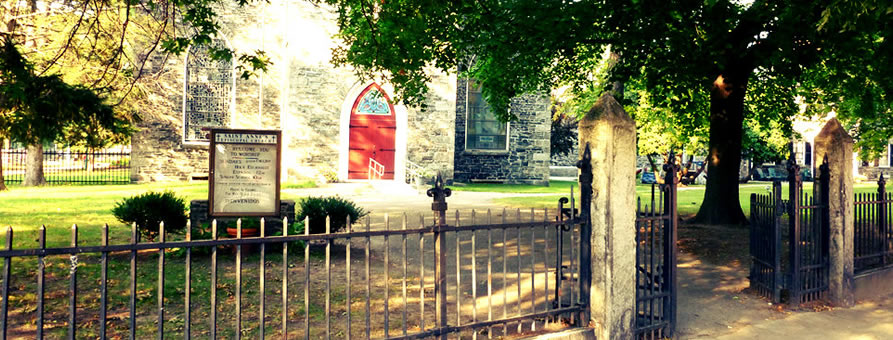Some Treasures
Baptismal Font | Bell Tower | Lectern and Eagle | Organ | Pulpit
The Baptismal Font
Constructed of hand-carved stone with a mahogany cover, this was purchased in England with monies donated by “the young ladies of the Parish.” It was procured in 1852 by the Bishop of Frederickton and brought to St. Anne’s for a total cost of $50.
The artist James Whistler, known for painting Whistler’s Mother, was baptized at Saint Anne’s in 1834 before this font arrived, but it has served at many other baptisms in the past 160+ years.
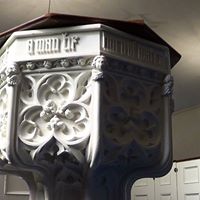
The Baptismal Font
The Bell Tower
A circular staircase in the narthex (which closed to the public for liability reasons) ascends to a room containing 11 bells that were installed in 1857 at a price of $4,200. Each bell has its own pitch and is inscribed with a name and a description. Together, the bells weigh five tons. The bell tower contains graffiti from the 1800’s through the 1960’s where soldiers going off to war left messages for loved ones. The bells are still played on special occasions, although there are few people who are trained to play them. For this reason, we have installed an electronic system to supplement them.
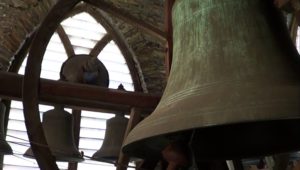
The Bell Tower
The Eagle Lectern and Reading Desk
The original Eagle Lectern was an 1869 memorial gift and is now part of the Chapel.
The Eagle Lectern that is currently in the Sancturary is an 1899 memorial gift. The reading desk, made of rosewood and mahogany, is part of the original church furnishings dating back to 1825. It originally stood at floor level. At the time of the 1884 renovation, it was elevated onto its present platform, and the steps were added.
The three pews in the left front by the Eagle pulpit were reserved for orphans.
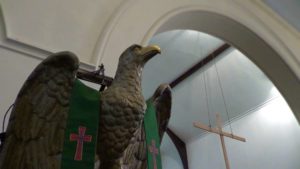
The Eagle Lectern
The Organ
When St. Anne’s Church was built in 1825, it had no organ. In 1828, the church purchased a two-manual organ from William M. Goodrich, the leading organ builder in Boston. The cost was $1,360.00, of which $1,000.00 was donated by the Merrimack Corporation.
In 1853, the Goodrich organ was sold to a church in Hudson and replaced by an organ of two manuals and 17 stops built by William Stevens of Cambridge. The Stevens organ was subsequently moved to the residence of George Metcalf, and later rebuilt and enlarged for the Centralville Methodist Church.
Both of these organs, along with the choir, occupied the rear gallery of the church.
In 1884 the 1825 building was enlarged by the addition of the present chancel. The choir, by then consisting of men and boys, was moved to two sets of facing choir stalls in the new chancel, and an organ of three manuals and thirty stops, built by the Hook & Hastings company of Boston, was installed on the left-hand side of the chancel.
Like its two predecessors, the Hook & Hastings organ originally had mechanical (“tracker”) key and stop action and a console attached to the side facing the choir. It was dedicated on November 20, 1884, in an organ recital by Samuel Brenton Whitney, organist of the Church of the Advent in Boston, which included two sacred solos by Master George E. Warring, boy soprano.
In 1929, the Hook & Hastings organ was rebuilt by William W. Laws of Beverly, Mass., who electrified the action, installed a new Austin console at the opposite side of the chancel, and added a fourth manual division in the form of a ten-stop Echo Organ located above the entrance at the opposite end of the room.
In 1972, a few tonal alterations were made to Great and Swell divisions by Wilson Barry of Andover, Mass., who also made some mechanical repairs, and the organ was rededicated on April 23. In 2002, the Echo Organ was rebuilt by Scot Huntington of Stonington, Conn., who converted it tonally into a more assertive Processional Organ.
The Organ Chamber, part of the 1884 addition, was specifically built to house the organ pipes of the Hook and Hastings organ. There are over 3000 metal and wooden pipes in three divisions enclosed in this space. All the pipes you see are working parts of the organ.
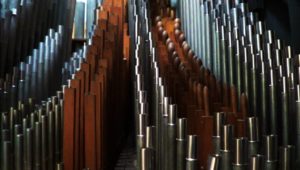
The Organ
The Pulpit
Constructed of rosewood and mahogany, the pulpit is a part of the original church furnishings of 1825. It stood several feet higher on an hourglass stem, but was reduced to its present height during the renovation of 1884. The carving of “IHS” is the seal of Pope Francis from the 1800s and is also a seal of the Jesuit Order. Both are non-Episcopal icons, indicating the Church’s strong connection to the Catholic Faith.
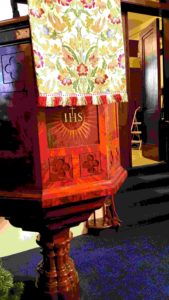
Pulpit
